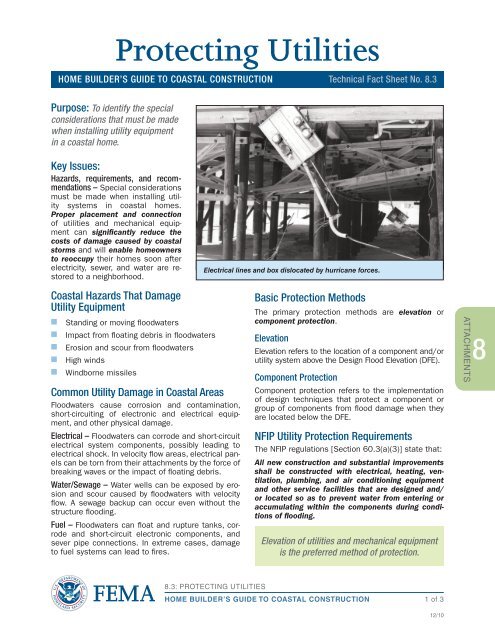FEMA P-499: Home Builder's Guide to Coastal Construction
FEMA P-499: Home Builder's Guide to Coastal Construction
FEMA P-499: Home Builder's Guide to Coastal Construction
You also want an ePaper? Increase the reach of your titles
YUMPU automatically turns print PDFs into web optimized ePapers that Google loves.
Purpose: To identify the special<br />
considerations that must be made<br />
when installing utility equipment<br />
in a coastal home.<br />
Protecting Utilities<br />
HOME BUILDER’S GUIDE TO COASTAL CONSTRUCTION Technical Fact Sheet No. 8.3<br />
Key Issues:<br />
Hazards, requirements, and recommendations<br />
– Special considerations<br />
must be made when installing utility<br />
systems in coastal homes.<br />
Proper placement and connection<br />
of utilities and mechanical equipment<br />
can significantly reduce the<br />
costs of damage caused by coastal<br />
s<strong>to</strong>rms and will enable homeowners<br />
<strong>to</strong> reoccupy their homes soon after<br />
electricity, sewer, and water are res<strong>to</strong>red<br />
<strong>to</strong> a neighborhood.<br />
<strong>Coastal</strong> Hazards That Damage<br />
Utility Equipment<br />
n Standing or moving floodwaters<br />
n Impact from floating debris in floodwaters<br />
n Erosion and scour from floodwaters<br />
n High winds<br />
n Windborne missiles<br />
Common Utility Damage in <strong>Coastal</strong> Areas<br />
Floodwaters cause corrosion and contamination,<br />
short-circuiting of electronic and electrical equipment,<br />
and other physical damage.<br />
Electrical – Floodwaters can corrode and short-circuit<br />
electrical system components, possibly leading <strong>to</strong><br />
electrical shock. In velocity flow areas, electrical panels<br />
can be <strong>to</strong>rn from their attachments by the force of<br />
breaking waves or the impact of floating debris.<br />
Water/Sewage – Water wells can be exposed by erosion<br />
and scour caused by floodwaters with velocity<br />
flow. A sewage backup can occur even without the<br />
structure flooding.<br />
Fuel – Floodwaters can float and rupture tanks, corrode<br />
and short-circuit electronic components, and<br />
sever pipe connections. In extreme cases, damage<br />
<strong>to</strong> fuel systems can lead <strong>to</strong> fires.<br />
Electrical lines and box dislocated by hurricane forces.<br />
8.3: PROTECTING UTILITIES<br />
Basic Protection Methods<br />
The primary protection methods are elevation or<br />
component protection.<br />
Elevation<br />
Elevation refers <strong>to</strong> the location of a component and/or<br />
utility system above the Design Flood Elevation (DFE).<br />
Component Protection<br />
Component protection refers <strong>to</strong> the implementation<br />
of design techniques that protect a component or<br />
group of components from flood damage when they<br />
are located below the DFE.<br />
NFIP Utility Protection Requirements<br />
The NFIP regulations [Section 60.3(a)(3)] state that:<br />
All new construction and substantial improvements<br />
shall be constructed with electrical, heating, ventilation,<br />
plumbing, and air conditioning equipment<br />
and other service facilities that are designed and/<br />
or located so as <strong>to</strong> prevent water from entering or<br />
accumulating within the components during conditions<br />
of flooding.<br />
Elevation of utilities and mechanical equipment<br />
is the preferred method of protection.<br />
HOME BUILDER’S GUIDE TO COASTAL CONSTRUCTION 1 of 3<br />
12/10<br />
ATTACHMENTS<br />
8


